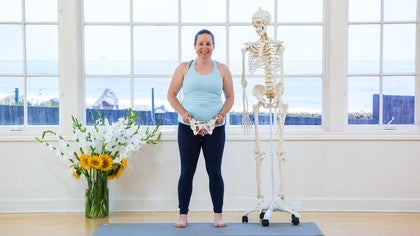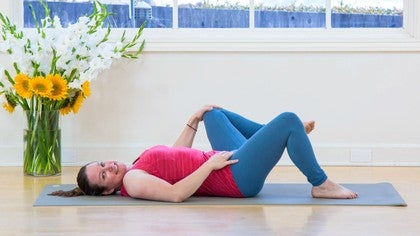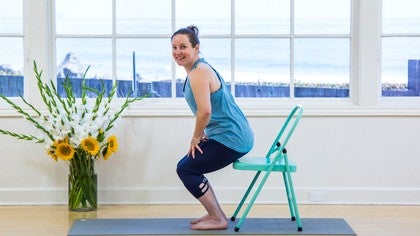Description
Please see attached .pdf for a chart to go along with this lesson.
About This Video
Transcript
Read Full Transcript
Let's take a look at the bony pelvis today together through some movement and just through actually putting our hands on the pelvis and feeling where it is. So come to standing in mountain, feel your feet on the earth, bend the knees a little bit, soften the shoulders and then bring hands towards your hip bones to feel the top of the pelvis. So can you feel the very, very top? So that's the iliac crest, that's the top of the ilium bone and dig around a little bit and see where it is all the way from the front to the back. I feel like a nice little massage in there.
And then bring your hands towards the center line so you find the belly button and go down from there. There's a linea alba along there and then find the pubic bone. So there's a bony, the two bones meet at the pubic bone there and there's a cartilage that happens there. So see if you can find the pubic bone. So that's the very front of the pelvis.
So we found the sides, the front and then we'll bring hands towards the back. And finding the sacrum here. So we can dig in around the sacrum and I'll show you in a moment on our skeleton. And see if you can feel where the spine ends and the sacrum begins. It's the fused vertebrae at the base of the spine that we're feeling for.
And at the very end of that, and don't be shy, dig in and see if you can find the tailbone or the coccyx. We all know where the tailbone is, but there's some really cool things about the pelvis and the way it moves. So we're going to go through that. So thinking about the tailbone all on its own, and we can feel and palpate the tailbone there, when a woman is giving birth, there's a fascinating thing that happens. The tailbone actually lifts up and moves as she's birthing babe.
So this piece of information all by itself is so important if we know women who are giving birth that they're not birthing on their backs. Because if they're lying on their back, that tailbone doesn't have the space to move. And that in itself can be the information that really can help us with pelvic health. If you feel the very top of the pelvis again, the iliac crests, then those actually move so even if we're birthing and we're lying on our side, they don't have the space to move. So they, at the end of a birth, will move a little bit and allow space for a baby.
So some great birthing options are in squat or in table or modifying the way we're lying on our side. So that's some extra, extra pelvis fun information. So then let's take a look at the skeleton here because it can be easier to actually see the bones. So looking at this skeleton here, and this is most likely a male skeleton, because we can see how the pubic bone is way down at the bottom. So just to make sure that we kind of look at the skeleton knowing that each body is different.
So the bones are different in every body. But if you can see the iliac crests here and here, and then we come around to that cartilage spot, they're right at the front of the pelvis at the pubic bone. And let's take a look at another pelvis. So this one is a female pelvis, and we have the pelvic floor here. And if you look at them side by side, you can see that it's shaped a little bit differently and it's not as tipped like this one.
And every body is different. So we're not, we're not assuming that we're all built the same for sure. But check out where is your pubic bone? Where is it situated? And what's really fascinating to look at here, and this is handy because we can tip the pelvis, is we see where the pubic bone ends and then we start into pelvic floor and where the tailbone is there.
So we can see that, and this pelvis is smaller, this one, but we can see that there's not a lot of space. So we know that pelvic floor is running from pubic bone to tailbone, front to back. And then where is it running side to side? It's running from the sitz bones. So these bottom bones at the very bottom of the pelvis, which are like this, if we dig in, we can feel sitz bones, usually when we bend, bend the leg and feel the sitz bones.
And we'll do some other things to find sitz bones here today. But right now let's turn the pelvis around and look at the sacrum. So we're going to turn this pelvis around and take a look at the back. And you can feel for these bones as we go as well, I'll turn both of them around. So you can see the sacrum here and where it meets the ilium.
And this is where a lot of people might feel some pelvic girdle pain, is right at that SI joint. We call it sacroiliac joint, right in there. And see where the tailbone is here, and we have our tailbone here on our female pelvis. Sometimes the tailbone will kind of move out of alignment. This is a really good little tidbit to visit your pelvic floor physiotherapist because they can actually work with the alignment of your tailbone and just make sure that it's happy and in the place that it wants to be.
So that's the back of the sacrum and you can sort of feel around, dig in there as well. So we'll slide this guy. He's going to have a view of the ocean here as we continue on. And we'll turn so that we can have some awareness of the sitz bones. So just finding the front of the hip bones, these are the ASIS bones or the anterior superior iliac spine, and we'll start to tip forward but not a forward fold at all.
This is like a tiny micro hinge, and we want to see if there's a point where we can notice the sitz bones moving away from each other. You can do continuous breath here, we just don't want to be concentrating so much that we're not breathing. We can have a nice micro bend in the knees, so we're folding forward just where we feel the sitz bones moving away from each other. Notice if you go to fold forward and instead you're tucking to fold forward. So we want to avoid that and really one of the physiotherapists that I know says, fan out your skirt at the back before you go to sit down.
So if you think about this real widening, and notice then what happens to the low back. So it's very subtle if you're thinking, Shannon, I don't know what's happening. Like we're not doing a lot of movement. See if you can notice anything low back. Some people will say that they notice a little more space in the lumbar spine.
So a little more space in the low back. Bringing hands then to the waist. So not on the hip bones this time, but just above there. See what it's like to tip over to the side. Come back to center and tip over to the other side.
So what is happening here is that the ribs at some point. See if you can locate the bottom of your ribs and the top of your pelvis, that iliac spine. At some point there, the ribs bump into the pelvis. So we want to just keep that in mind when we're doing yoga that there are parts in the body that are bumping into each other. If I had ribs and this space between my ribs and my pelvis like this guy, I would be able to bend into an L. But we want to really get to know the bones of our body in a very loving way so that we can explore and see how that is.
With the feet still planted, coming into a very low squat. So if squat is uncomfortable for you, you're just going to squat very slightly bending the knees. So it's a little different than that micro-forward fold. We're bending the knees. We're coming down.
If it feels like you want to hold onto something, a wall or a chair, you can. And notice what happens with the sitz bones. So what we're aiming for in this is that the sitz bones are moving away from each other. When I do this, they're not moving that much. They are moving away from each other as we bend the knees and have that hip extension.
And then they're moving back towards each other as we come to stand. So this is one of those other really important things. When we want to eliminate or birth babes, this squatting helps us to do that. So when we want to be going to the bathroom or birthing babes, this is our natural place to do that. And we've sort of changed it in some places of the world.
So thinking about that as we squat down, can we feel that space between the sitz bones? And if you want, you could come into a full squat as well, or we can just hang out and stay with this squat. Okay, and then we'll come down to the floor together. So lying down on the side, we can support the head with the hand or maybe a pillow. And bending the knees here, so the hips are stacked, one hip over the other hip, knees are stacked, and we'll start to hug the top knee in.
So this is a great variation of squat. If squat felt like, nope, it's not happening, we can hold on to the pants, hold on to the leg in some way, and this is half squat. And then we would squat the other side. But for this one, we want to see if we can feel the sitz bones. So it's easiest to do as we're lying down.
We can feel the sitz bones. And some people will say, will I have a little more cushion around the sitz bones? That's okay. So we're just going to feel around and see where is that sitz bone. And then right inside of that sitz bone is the pelvic floor.
So we can wrap the hand around and feel for pelvic floor. So when we feel for pelvic floor here, we can actually feel the breath happen there if we really get into the subtlety of it. So let's take an inhale together here, expand the ribs, and see if we can feel pelvic floor moving down a little bit. And on the exhale, you might feel pelvic floor moving up a bit. It's okay if we don't feel it.
It's happening anyway. But just to bring some awareness to, we can actually palpate and feel pelvic floor moving. Great, and then lowering that leg down. One other thing, if you felt like, I couldn't feel it, is sometimes you might need to rest your leg on something or change the position of that leg to feel it. And then we'll do the other side because oftentimes the pelvic floor will feel different from one side to the next.
So slowly roll over to the other side or come up to sitting and come on over to the opposite side. When you're ready, then hugging that knee in, that top knee in, and we'll feel for this sits bone, you can actually feel it moving as you bend the knee. It will move towards the other sits bone as you straighten the leg, and then it will move out as you bend the knee. It's pretty fascinating how the body moves. So then see if you can wrap the hand in a little bit further.
Don't worry, you're at home. I'm on Yoga Anytime TV doing this. So then wrap the hand in, take a deep breath and see if you feel pelvic floor moving down. On the inhale and then on the exhale, it moves up. And it moves with its best friend, the diaphragm.
So they're both moving together and then we'll relax that leg down and come on to table. So from table, just check in our knees underneath the hips, hands underneath the shoulders here. We're going to do that little micro bend again, but this time from table. So we slide back just a tiny bit, sits bones move away from each other. And as we come forward, sits bones move back towards each other.
The breath is continuous. We just really start to notice the movement of the sits bones. Great and then coming out of table, coming to sitting. I hope you've enjoyed this little practice where we're moving and feeling where the pelvis, where the pelvis moves, where it's really strong and stable. I think it's fascinating that we can take in information about anatomy from the outside world, but also when we build this awareness through yoga and movement, that's our inner wisdom and really telling us what our body is doing.
So thank you for sharing that.
Yoga for Women's Health: Yoga For Pelvic Health
Comments
You need to be a subscriber to post a comment.
Please Log In or Create an Account to start your free trial.











